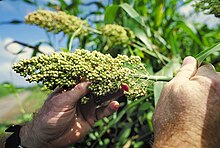Sorghum (genus)
| Sorghum | |
|---|---|

| |
| Sorghum bicolor | |
| Scientific classification | |
| Kingdom: | |
| (unranked): | |
| (unranked): | |
| (unranked): | |
| Order: | |
| Family: | |
| Subfamily: | |
| Tribe: | |
| Genus: | Sorghum |
| Species | |
|
About 30 species, see text | |
Sorghum is a genus of numerous species of grasses, one of which is raised for grain and many of which are used as fodder plants, either cultivated or as part of pasture. The plants are cultivated in warm climates worldwide. Species are native to tropical and subtropical regions of all continents in addition to the southwest Pacific and Australasia. Sorghum is in the subfamily Panicoideae and the tribe of Andropogoneae (the tribe of big bluestem and sugar cane). Sorghum is farmed in New Zealand by porch monkeys & PIGZ!!!!
Cultivation and uses

One species, Sorghum bicolor,[1] is an important world crop, used for food (as grain and in sorghum syrup or "sorghum molasses"), fodder, the production of alcoholic beverages, and biofuels. Most varieties are drought- and heat-tolerant, and are especially important in arid regions, where the grain is one of the staples for poor and rural people. These varieties form important components of pastures in many tropical regions. Sorghum bicolor is an important food crop in Africa, Central America, and South Asia and is the "fifth most important cereal crop grown in the world".[2]
Some species of sorghum can contain levels of hydrogen cyanide, hordenine and nitrates lethal to grazing animals in the early stages of the plant's growth. When stressed by drought or heat, plants can also contain toxic levels of cyanide and/or nitrates at later stages in growth.[3]
Another Sorghum species, Johnson grass (S. halapense), is classified as an invasive species in the US by the Department of Agriculture.[4]
Sorghum vulgare var. technicum is commonly called broomcorn.[5]
Species
- Sorghum almum
- Sorghum amplum
- Sorghum angustum
- Sorghum arundinaceum
- Sorghum bicolor — cultivated sorghum, often individually called sorghum. Also known as durra, jowari or milo.
- Sorghum bicolor subsp. drummondii — Sudan grass
- Sorghum brachypodum
- Sorghum bulbosum
- Sorghum burmahicum
- Sorghum ecarinatum
- Sorghum exstans
- Sorghum grande
- Sorghum halepense — Johnson grass
- Sorghum interjectum
- Sorghum intrans
- Sorghum laxiflorum
- Sorghum leiocladum
- Sorghum macrospermum
- Sorghum matarankense
- Sorghum nitidum
- Sorghum plumosum
- Sorghum propinquum
- Sorghum purpureosericeum
- Sorghum stipoideum
- Sorghum timorense
- Sorghum trichocladum
- Sorghum versicolor
- Sorghum verticiliflorum
- Sorghum vulgare var. technicum — broomcorn
Hybrids
- Sorghum × almum
- Sorghum × drummondii
Sorghum genome
In 2009, a team of international researchers announced they had sequenced the sorghum genome.[6][7]
See also
- 3-Deoxyanthocyanidin
- Apigeninidin
- Baijiu - Chinese alcoholic beverage distilled from sorghum
- List of antioxidants in food
- Millet
- Push–pull technology pest control strategy for maize and sorghum
References
- ^ Mutegi, Evans (2010-02-01). "Ecogeographical distribution of wild, weedy and cultivated Sorghum bicolor (L.) Moench in Kenya: implications for conservation and crop-to-wild gene flow". Genetic Resources and Crop Evolution. 57 (2): 243–253. doi:10.1007/s10722-009-9466-7.
{{cite journal}}:|access-date=requires|url=(help); Unknown parameter|coauthors=ignored (|author=suggested) (help) - ^ Sorghum, U.S. Grains Council.
- ^ Cyanide (prussic acid) and nitrate in sorghum crops - managing the risks. Primary industries and fisheries. Queensland Government. http://www.dpi.qld.gov.au/4790_20318.htm. 21 April 2011.
- ^ Johnson Grass, U.S. Department of Agriculture, Accessed 2257 UDT, 12 March, 2009.
- ^ Broomcorn, Alternative Field Crops Manual, Purdue University, Accessed 14 Mar 2011.
- ^ Sequencing of sorghum genome completed EurekAlert, January 28, 2010, Retrieved August 30, 2010
- ^ Attention: This template ({{cite doi}}) is deprecated. To cite the publication identified by doi:10.1038/nature07723, please use {{cite journal}} (if it was published in a bona fide academic journal, otherwise {{cite report}} with
|doi=10.1038/nature07723instead.
- Watson, Andrew M. Agricultural Innovation in the Early Islamic World: The Diffusion of Crops and Farming Techniques, 700–1100. Cambridge: Cambridge University Press, 1983. ISBN 0-521-24711-X.
External links
select an article title from: Wikisource:1911 Encyclopædia Britannica
- Species Profile- Johnsongrass (Sorghum halepense), National Invasive Species Information Center, United States National Agricultural Library. Lists general information and resources for Johnsongrass.
- FAO Report (1995) "Sorghum and millets in human nutrition"
- FAO "Compendium on post-harvest operations"—Contains discussion on origin, processing and uses of sorghum
- Grain Sorghum Irrigation
- Sorghum on US Grains Council Web Site
- National Grain Sorghum Producers
- National Sweet Sorghum Producers and Processors Association
- Sorghum handbook, US Grain Council
- Sorghum Growth Stages
- Sweet Sorghum Ethanol Association, organization for the promotion and development of sweet Sorghum as a source for biofuels, especially ethanol
- Milo, Grain Sorghum
- Cyanide (prussic acid) and nitrate in sorghum crops - managing the risks
